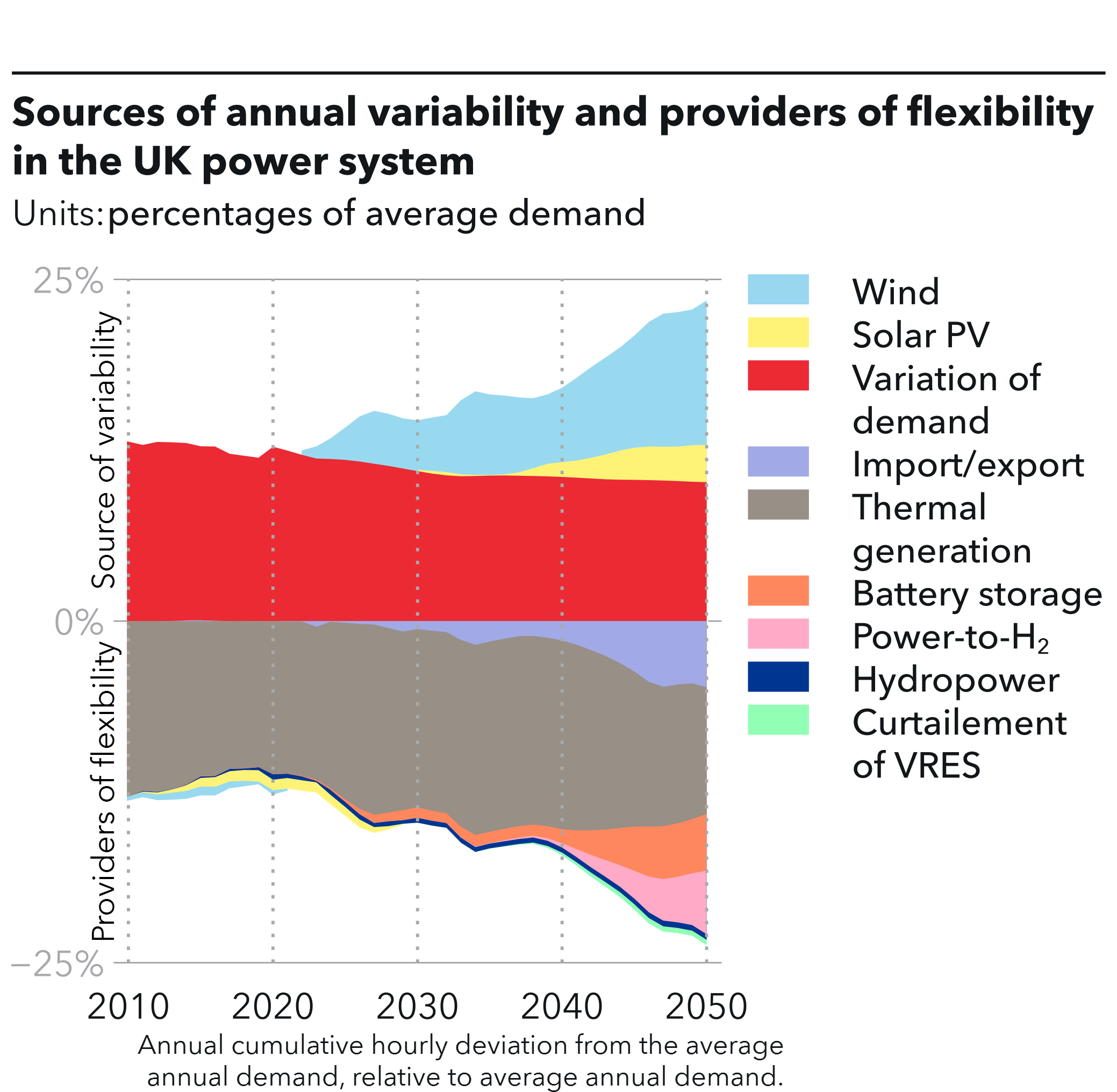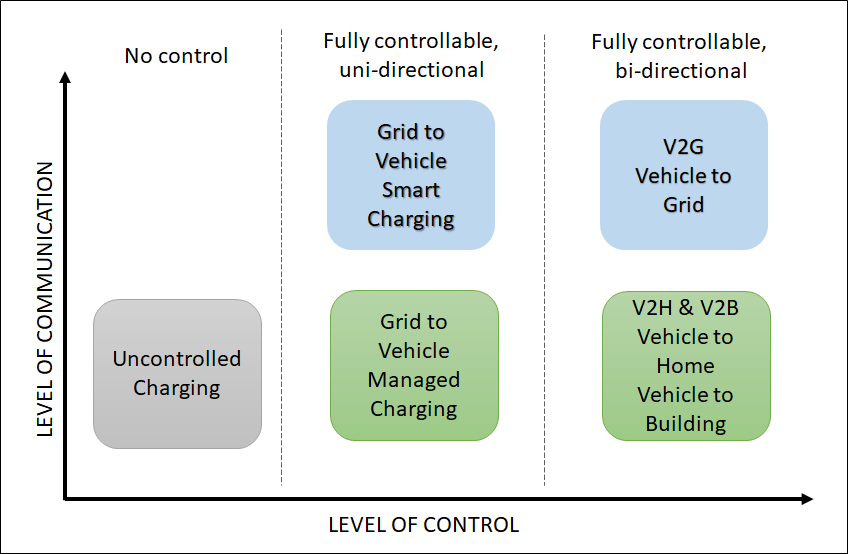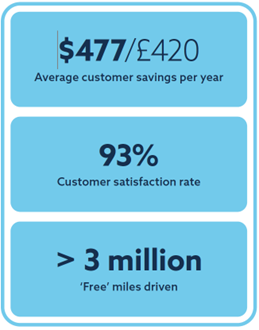There are very large potential benefits – to consumers and grid operators alike – in leveraging the battery capacity of the fast-growing EV fleet to enhance flexibility in power systems.
This article details the concepts of vehicle-to-grid (V2G) and vehicle-to-everything (V2X) technology. We then summarise the very encouraging results from the world’s first and biggest rollout of V2G technology, pioneered by the UK-based tech company Kaluza, which is developing platform technology to accelerate a sustainable, affordable, and resilient energy transition.
In most power systems, electricity demand can change very quickly. To cope with these changes, the system needs to respond quickly and ensure that the amount of electricity produced matches the amount used. This means that the system needs to be monitored continuously in real-time to track things like voltage, frequency, and power flow. The system also needs to be able to adjust aspects like the amount of power being generated and how transformers are configured in real time to maintain stability. As more and more renewable energy sources like wind and solar are being used, there is an even greater need for power systems to be flexible and adaptable to balance supply with demand.
The need for flexibility in power systems
Measuring the requirement for flexibility and delivering against those data is a complex undertaking, and can encompass a range of services spanning from fractions of a second to seasonal time scales. Nevertheless, our Energy Transition Outlook provides a compelling demonstration of the mounting demand for flexibility, as we have calculated the hourly fluctuation of electricity demand and supply from the annual average for all the regional power systems we model globally over the course of our forecast period. This is depicted in Figure 1 for the UK power system (DNV, 2022a, 2022b).

Figure1 Sources of annual variability and providers of flexibility in the UK power system
Historically, the source of variability in the electricity system has been changes in demand, as electricity consumption varies on a daily and monthly basis. In 2010, for example, this variability amounted to an average of 13%, or roughly 5.5 GW based on the annual average demand of 42 GW. To address this issue, the power system relied on the dispatchable generation technologies such as coal and gas-fired power plants, which could be easily adjusted to accommodate changes in demand.
The future of energy flexibility
According to our projections, solar energy will account for 10% of the UK's electricity production by 2050, while onshore and offshore wind power will together provide two-thirds of the total output. However, the intermittent nature of these renewable sources will result in nearly twice the annual variability in residual demand (the difference between overall demand and the electricity supplied by wind and solar sources) compared with today.
Rising variability in electricity supply is poised to trigger fluctuations in wholesale prices, ranging from zero or even negative electricity prices during periods of ample solar and wind power, to hours of supply scarcity when costly gas generators dictate rates. This new reality, when paired with the declining cost of storage, presents an opening for energy storage to offer greater flexibility by way of ancillary services or price arbitrage. Yet, storage providers must brace for stiff competition from alternative solutions vying for a slice of the flexibility market.
The battle for flexibility
Despite its diminishing share in overall annual electricity supply, dispatchable generation will remain an essential component for ensuring flexibility. In addition, interconnections with neighbouring nations will become increasingly critical. In the case of the UK this includes France, the Netherlands, Ireland, Norway, and potentially even with Morocco. The production of hydrogen using inexpensive electricity is another means of enhancing flexibility, with most of the hydrogen destined for the hard-to-electrify aspects of manufacturing or to be used as e-fuels in the aviation and maritime sectors. Owing to the energy losses associated with thermal power generation, only a minor proportion of this precious green hydrogen will be converted back to electricity.
Enter the EV fleet
An increasingly viable option for enhancing flexibility in the energy sector is leveraging the battery capacity of electric vehicles (EVs) as a means of storage. With the power grid transitioning from a conventional, unidirectional energy delivery model to a more decentralized one, where consumers actively contribute to the generation of electricity, the significance of flexible solutions at the consumer level, such as EV batteries, is critical. It provides grid-connected storage for overall flexibility and, as we detail below, potentially much more….
The concept of vehicle-to-everything (V2X)
V2X technologies, including vehicle-to-grid (V2G), vehicle-to-home (V2H), and vehicle-to-building (V2B), have the potential to revolutionize the way we use and manage energy in transportation and buildings. V2G is a concept that enables EVs to not only draw power from the grid but also provide power back to the grid. Fundamentally, this process entails the utilization of parked and unutilized EVs as a source of power for the electricity grid during periods of high demand, while simultaneously returning that power back to the same EVs during times of low demand. This mechanism permits the grid to draw on EVs' stored energy to accommodate sudden surges in power requirements, such as when households collectively activate high-powered electrical appliances, like kettles, during half-time breaks in a football game. The EVs' battery power is replenished in the early hours of the morning when people are sleeping, and the electricity load is low.
V2H is a small-scale version of V2G. It allows homes to be supplied with power stored in the EV’s battery through the home power network, serving as a backup energy source. V2B follows a similar concept, and setups can vary between the connection to a single-family home or an apartment building. V2H and V2B do not directly affect the grid but contribute to a local balance by providing energy to power the building even during power outages. Figure 2 illustrates the different levels of communication and control for simple charging and V2X applications.
How does it work?
V2X systems use a combination of hardware and software, including vehicle controllers, inverters, and communication protocols, to enable the bi-directional flow of power and data between EVs and external systems. These systems rely on standard communication protocols such as CHAdeMO, Combined Charging System (CCS), and Open Charge Point Protocol (OCPP) to ensure interoperability between different systems and technologies. The EV is equipped with a bi-directional charger (AC–DC and DC–DC) that can both charge the vehicle's battery and discharge energy back to the grid or home/building (Tan, 2019). Additionally, the charging infrastructure includes a smart charging station that communicates with the vehicle and the respective grid, monitoring the battery's state of charge and adjusting the charging rate to optimize the vehicle's charging and discharging behaviour. Most major OEMs committed to deliver V2X-compatible electric cars in this decade while charge point manufacturers have made a similar commitment.

Figure2 Levels of Vehicle to X applications (adapted from Cox (2019))
Benefits
One major benefit of V2X technology is its potential to stabilize the grid by providing additional flexibility and balancing services to better manage peak demand periods and reduce the need for costly and polluting peaker plants and thus allow for the integration of more renewable energy sources (Ravi and Aziz, 2022). For end users, V2G technology can provide an additional revenue stream. EV owners can sell the stored energy in their vehicle's battery back to the grid during peak demand periods, earning credits or cash payments. This can help offset the cost of owning an EV and make it more affordable for more people to adopt this clean energy technology.
Barriers
One of the biggest barriers to wider V2X integration is the lack of interoperability and standardization between different systems and technologies. There are currently no universal standards for V2X communication protocols, making it difficult for different systems to communicate and exchange data. This can lead to compatibility issues and increased costs for implementation, as different systems may require different hardware and software.
Another barrier to V2X adoption is the limited availability of charging infrastructure and grid capacity. V2X technologies rely on a reliable and accessible charging network and sufficient grid capacity to manage the bi-directional flow of electricity.
Additionally, the cost of implementing V2X technologies can be a significant barrier. While V2X has the potential to provide benefits to both the grid and end users, the upfront costs of hardware and software installation, as well as ongoing maintenance and monitoring, can be prohibitively expensive for many.
Finally, the digital steering of the technical integration needs to be intuitive and accessible, for example the UX for older homeowners or late-night workers who might need a charged battery to commute to a shift.
Outlook
Vehicle-to-everything’s future application in the energy transition is promising due to its potential to provide flexible and sustainable energy solutions. However, the development and implementation of V2X is currently region-specific and reliant on the availability of charging infrastructure, grid capacity, and supportive policies.
We will provide more in-depth analysis and insights on the topic of V2G and the development of the transport sector in the global energy transition in our upcoming Transport in Transition Report, which will be launched May 4th 2023.
A detailed look into the world`s first and largest domestic V2G programme
To connect our model and insight-based findings with real world applications, software company Kaluza presents findings from the world`s first and largest domestic V2G program launched by OVO, one of the UK’s largest energy service providers (ESPs) alongside major auto OEM Nissan and Kaluza, the software provider.
During this 36-month project, Kaluza intelligently managed the charging of EVs by analysing real-time market signals (such as grid supply, weather and pricing data), and charging cars when prices and carbon levels are low. By integrating with V2G charge points, Kaluza controlled when cars stored energy and exported it back into the grid in response to spikes in demand. Customers could use Kaluza’s intuitive app to tell the platform when they would like their cars to be ready to drive by and then Kaluza would optimize the charging to ensure they were using the cheapest and greenest energy.
Kaluza’s V2G partnership with OVO Energy and Nissan resulted in 330 V2G devices installed across the country and over 3 million free miles made available to customers who exported energy back to the grid during peak times. It showed that V2G has the potential to save £3.5bn per year on grid infrastructure reinforcement, and that customers can earn an average of £420 to as much as £800 per year without needing to do anything except keep their cars plugged in when they are not in use.
Findings from the trial also showed an extremely high level of satisfaction, and a reduction in concerns relating to V2G, among customers. A total of 93% of customers reported satisfaction with their V2G hardware throughout the course of the trial. The level of concern around battery health dropped from 61% at the beginning of the trial to 24% at the end, and worries about cost savings while using V2G dropped from 43% to 28%.

Figure 3 Potential savings from V2G trial
Through implementing bidirectional EV charging that allows car owners to earn money by selling surplus energy back to the grid, Kaluza is showcasing how V2G can be used as a pivotal component of the robust, zero carbon energy system of the future.
This project also highlighted key areas of development that are needed to support the success of V2G technology at scale in the UK. While further development is still needed across hardware and installation costs, vehicle compatibility and energy market reform, it is clear that UK drivers are increasingly excited and prepared for the energy transition, and utilities need to be prepared to help them participate in decarbonization.
Infinitely scalable capabilities such as V2G will become increasingly necessary and valuable as millions more electric cars and heating systems connect to the energy system. By 2030, when the UK could have almost 11 million EVs on the road, smart charging of this kind has the potential to stop 146,239 tonnes of carbon being produced each year.
This year, Kaluza is partnering with Volkswagen Group UK, OVO Energy and Indra on INFLEXION, the world’s first vehicle-to-everything (V2X) trial. The INFLEXION consortium will build on Kaluza’s V2G deployment and empower future EV drivers to unlock further potential from their vehicles, including to power their homes (V2H), and using Combined Charging System (CCS) technology to enable millions more drivers to reap the benefits of this, regardless of which EV they own.
References
Cox, C. (2019) Vehicle-to-Grid: Learnings from 5 years of Development. Available at: http://www.regen.co.uk/wp-content/uploads/Regen-V2G-Learnings-Sept-2019-v2.pdf. Last accessed March 22, 2023
DNV (2022a) Energy Transition Outlook – A Global and Regional Forecast to 2050. Available at: https://www.dnv.com/energy-transition-outlook
DNV (2022b) Energy Transition Outlook UK 2022 – A national forecast to 2050. Available at: https://www.dnv.com/energy-transition-outlook/download-uk.html
Ravi and Aziz (2022) Utilization of Electric Vehicles for Vehicle-to-Grid Services: Progress and Perspectives. Energies 2022, 15, 589. https://doi.org/10.3390/en15020589
Tan et al. (2019) A multi-control vehicle-to-grid charger with bi-directional active and reactive power capabilities for power grid support. Energies, Volume 171
